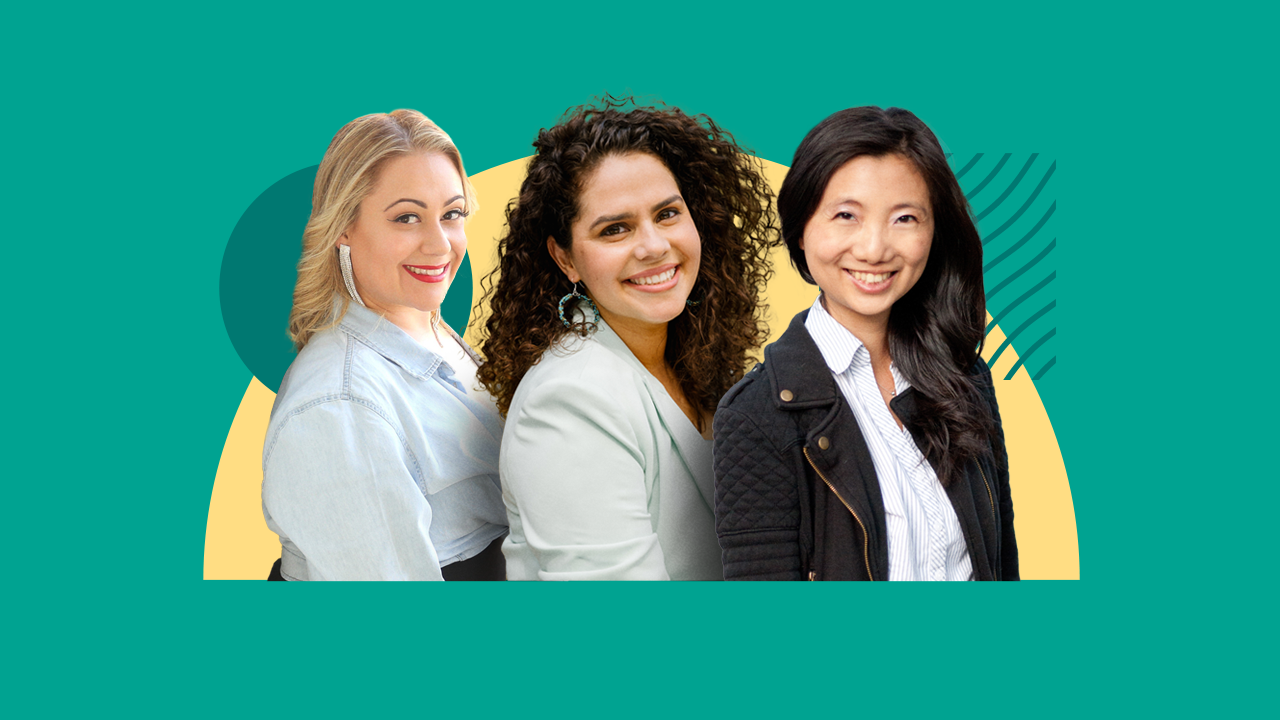Fueling the FIRE: How these diverse women are reshaping the road to financial independence

For years, the recipe for building wealth was straightforward: Graduate from college, get a good job, live below your means and invest the rest.
But a group of financial enthusiasts are veering off that path in favor of a more accelerated approach known as FIRE, or financial independence, retire early.
FIRE followers aim to exit the workforce years, even decades, ahead of schedule by drastically cutting expenses, boosting their income and investing heavily.
But like much of finance, FIRE blogs and Reddit threads are often dominated by non-diverse voices. We spoke with three women from diverse backgrounds who are challenging that stereotype and reshaping the conversation around financial freedom.
Meet three female FIRE followers:
- Jannese Torres: A Latina money educator, writer, business coach and host of the personal finance podcast “Yo Quiero Dinero.” Torres achieved financial independence two years ago when she earned enough from her side hustles to quit her six-figure engineering job.
- Rita-Soledad Fernandez Paulino: A former public school math teacher, Fernandez Paulino launched her financial education company, Wealth Para Todos, in 2021. Last year, her business generated about $100,000 in revenue. She and her husband plan to reach financial independence by age 47.
- Shang Saavedra: At age 31, Saavedra achieved financial independence after aggressively saving with her husband, launching a successful side gig and working a six-figure job. She founded Save My Cents, a financial coaching business, in 2016 and retired early in 2023 at the age of 37.
Here’s how these women are approaching the journey to financial independence, and how you can do it, too.
Find your motivation
Many Americans struggle to save enough money for retirement by age 65 — let alone 45 or even 35.
It takes hard work to retire early, so before you get started on your FIRE journey, understand your motivation.
For Torres, FIRE represents the freedom to walk away from her engineering career and pursue her creative passions full-time.
“You’re not withholding to company layoffs, downsizing or a pandemic,” says Torres, who quit her job in 2021 to pursue her company full time. “Financial independence makes work optional.”
For Saavedra, FIRE affords her the freedom to stay at home with her two young children while running her business part-time.
“Because my husband and I were saving for a goal bigger than ourselves — for our future children —- it felt very meaningful,” says Saavedra, who recently moved to California with her husband and two children. “The sacrifices we made didn’t feel like much of a sacrifice when we looked at it that way.”
Make a budget
Rita-Soledad Fernandez Paulino, a first-generation Mexican-American living in California, started her journey toward financial independence at age 32 when she created her first budget.
“Until then, I had just picked up side gigs, like babysitting, if I needed extra money,” she says.
The turning point came after Fernandez Paulino was forced to take medical leave from her job as a public school teacher.
While collecting disability and confined to bed rest, the mother of two says she decided to get a firm grip on her cash flow and create a budget.
“It made me be more intentional with my spending,” says Fernandez Paulino. “I used those budgeting skills to really buckle down and pay off my student loans.”
Pay off debt
Financial independence hinges on shedding student loan and credit card debt.
Fernandez Paulino paid off the rest of her and her husband’s $23,000 student loan balance in 2019 after trying to apply for the federal teacher student loan forgiveness program.
Meanwhile, Torres aggressively paid off her $39,000 student loan balance from 2016 to 2020, making extra payments using revenue from her food blog side hustle and additional windfalls, like tax refunds.
“Sometimes I would pay two, three, four times the minimum payment on my loans,” she says.
Torres also refinanced her loans four times, each time lowering her interest rate and shortening the repayment period.
Start saving
Frugality is a cornerstone of FIRE. Cutting expenses and learning to live on less are key strategies for building a massive nest egg in a short time.
Some FIRE followers embrace frugality more than others. Two subreddits, r/LeanFIRE and the more extreme r/PovertyFIRE, include members who live off $25,000 a year or less and plan to continue that minimalist lifestyle through retirement.
Saavedra, the daughter of Chinese immigrants, says she learned frugal habits from her parents. But in her mid-20s, Saavedra stepped up her saving habit in a big way.
She and her husband stuck to a strict budget when they were dating and after they married. They decided to live off just one person’s salary in New York City for several years, aiming to save about 50 percent of their income annually.
“Our thought was that if we learned to live off the lower of our two incomes, and then we had a kid, we wouldn’t worry about the added cost,” says Saavedra. “And one of us could potentially be a stay-at-home parent.”
The couple saved thousands of dollars a year by moving into a rent stabilized apartment, helping offset some of Manhattan’s high cost of living.
Neither owned a car and they both saved money on public transportation by walking as much as possible. Instead of pricey dinners in Midtown, the couple invited friends over for potlucks and home-cooked meals.
And since Saavedra and her husband were making six figures shortly after college, it didn’t take long for the couple to amass a major nest egg.
By the time Saavedra got married at age 28, she and her husband both had six-figure net worths.
A few years later, Saavedra says her personal net worth hit the $1 million mark.
“Frugality is really what drove the rapid growth in those final years before I hit $1 million,” she says.
In July 2023, at the age of 37, Saavedra left her full-time six-figure consulting job to retire early.
“I walked away because I wanted the freedom to do something else with my life and focus on being a mother,” she says.
Don’t sacrifice everything
Budgeting helped Fernandez Paulino reign in her spending and prioritize paying off her student loans, but she soon realized she couldn’t save her way to financial independence. Not on disability checks, or even a full-time teacher’s salary. She needed to earn more money.
“I like spending money,” says Fernandez Paulino. “I get a lot of joy out of shopping. So cutting back on everything I enjoy just didn’t feel sustainable.”
A subset of the FIRE movement, known as Fat FIRE (in contrast to Lean FIRE) favors a less frugal and more lenient approach to building wealth. People with this mindset don’t worry so much about making dramatic sacrifices today, but instead, focus on ratcheting up their earnings.
Torres thinks there’s too much emphasis on frugality in the broader FIRE movement.
“I want to still enjoy my life in the present,” she says. “I don’t want to keep living like a broke college student.”
As a Latina from a working-class Puerto Rican family, the thought of cutting back to bare essentials also conjured up unpleasant childhood memories of sacrifice and struggle.
“It was kind of a trigger to even think about going back to that mentality,” she says.
So while both Fernandez Paulino and Torres recommend creating a budget, getting a handle on your cash flow and saving money, they’re fueling their FIRE journey with our next tip: Earn more money.
Earn more money
To achieve FIRE, all three women aggressively pursued higher salaries and additional income streams.
Saavedra stressed the importance of asking for more money in your 9-5 job.
“You need to back up your negotiations with data,” she says. “Know what the competition pays, know what other people were able to achieve within the same company and at the same level.”
Saavedra says she often interviewed for jobs when she was employed just to gauge the market rate for a candidate with her background.
Saavedra and Torres started earning six-figure salaries shortly after college (Torres as an engineer and Saavedra as a management consultant), but they didn’t fully embark on the road to financial independence until they created their own side hustles.
Torres started her food blog, Delish D’Lites, in 2013 when she was 25. She was in-between jobs and decided to devote time to a creative pursuit.
“I always loved being in the kitchen and knew I wanted to do something around that,” says Torres. “It was just a hobby at first, an experimentation really.”
A few years later, Torres began chronicling her financial journey on social media. She interviewed money experts on her podcast Yo Quiero Dinero, which focuses on helping Latinas build wealth.
Success didn’t happen overnight, though. Torres says it took about seven years before she earned enough passive income from her food blog and other content streams to quit her day job and work her side hustles full-time.
Investing in education or training
At some point, each of these FIRE followers made the decision to pay for additional education or training to boost their earning potential.
- Fernandez Paulino spent $10,000 on a business coach before launching her financial education company, Wealth Para Todos, in 2021.
- Torres took classes on brand marketing and food blogging in New York City to bolster her content creation skills.
- Saavedra paid for workshops and seminars on wedding photography to improve her technical skills and grow her side hustle in her 20s.
Saavedra says she charged almost nothing to gain exposure when she first started her wedding photography business. After receiving additional training and improving her marketing skills, Saavedra was able to charge over $5,000 per wedding at the height of her side hustle.
Working with a financial advisor or a similar professional can help you map out your goals and avoid common pitfalls.
“You have to realize there are areas where you’re not the expert, and you may need to pay other experts to help you learn quickly,” Saavedra says.
Invest early and often
Investing in broadly diversified ETFs and index funds is a tried-and-true strategy used by millions of Americans to build wealth. It’s also how Saavedra grew her sizable investment portfolio.
“You can’t buy back time,” Saavedra says.
Index funds are a collection of assets, usually stocks or bonds, that share a common theme. Some of the most popular funds track the Standard & Poor’s 500 index — a collection of America’s biggest companies. It has a track record of about 8 percent annual returns over time.
The beauty of index funds is they offer instant diversification, so you don’t need to be an investing expert to get started.
“We just invest the way Warren Buffet says the average American should invest — cheap index funds,” says Saavedra. “I’m not a stock picker. That’s not my job.”
Saavedra says she bought many of those index funds inside tax-advantaged retirement accounts, including her workplace 401(k). When she started her financial education company, Save My Cents, in 2016, she also signed up for a SEP IRA.
SEP IRAs are a type of individual retirement account that allows a company to contribute up to the lesser of 25 percent of your compensation, or $66,000.
For workers who double as their own bosses, like Saavedra, a SEP IRA offers the chance to set aside much more money than they could in an employer’s 401(k) plan, which caps employee contributions at $22,500 in 2023 and $23,000 in 2024.
Set your FIRE number
The road to early retirement begins with your FIRE number, or the amount of money you need to save to live the lifestyle you want after exiting the workforce.
Many people pursuing FIRE follow the rule of 25, which means accumulating 25 times your annual expenses before retirement.
To get this number, first multiply your monthly expenses by 12. Then multiply that annual expense by 25 to get your FIRE number.
Looked at another way, 4 percent of your net worth should be equal to or greater than a year’s worth of living expenses. Why 4 percent? Over the long term, the stock market has historically returned over 8 percent annually on average, so 4 percent is a conservative enough withdrawal rate to keep your investments growing.
Fernandez Paulino set her withdrawal rate at the standard 4 percent due to her heavy stock allocation.
“If I were ever to change my asset allocation to have more bonds, I would change my withdrawal rate to 3 percent,” she says.
It’s important to consider the type of lifestyle you want in retirement. A higher withdrawal rate offers a more comfortable lifestyle, though you’ll need to save more money to afford and maintain it.
Optional: Pick a FIRE date
Traditionally, FIRE followers set a hard date to retire.
But the women we spoke to are interested in a more work-optional future, not a permanent departure from work.
“For me, it was about figuring out how much I needed to make to replace my six-figure salary,” says Torres, who achieved that goal in 2020. “Then I said if I could replicate that again, I would officially be financially independent.”
So, for Torres, she achieved financial independence in 2021 at age 35, though she still continues to run her businesses.
Saavedra was clear about her FIRE date: “I never set a date.”
She recognizes the value of work, citing its positive impact on mental well-being.
“I decided to continue working because it made sense for me personally,” she says.
According to Fernandez Paulino’s calculation, she should be able to retire financially independent by age 47 if her company meets annual revenue goals.
“I’ve really been focusing more on a work-optional life,” she says. “If I miss my FIRE date, that’s fine. I’m working for myself, doing what I want.”
She describes her FIRE date as aiming for the moon. Even if she fails, she’ll be among the stars.
“You’ll still set yourself up for a comfortable retirement later, even if you don’t hit your target FIRE date,” she says.
Overcoming your financial past
Achieving financial independence can be a psychological challenge, particularly for women of color and first-generation Americans who may be the first ones in their family to accumulate wealth.
“There can be this feeling of wealth guilt, of ‘who am I to even deserve this?’” says Torres.
For some people, feelings of unworthiness or insecurity can lead to self-sabotage, like failing to invest because you’re afraid of losing money in the stock market and letting down people who depend on you, says Torres.
Fernandez Paulino recalls crying in a meeting last fall when she realized she was on track to make $100,000 after launching her business.
“I kept thinking, ‘This doesn’t happen, this isn’t safe, this is crazy,’” she says.
Therapy can be helpful — in fact, all three women praised the benefits of therapy as a way to combat negative emotions and even address past financial trauma.
“You have to become very thoughtful about your narrative, the thoughts you repeat to yourself,” says Fernandez Paulino.
Find your community, practice self-care
While therapy is valuable, these women stress the importance of self-care and a strong support network, too.
Finding a community where you can celebrate your financial wins can be a game changer, says Fernandez Paulino, who felt discouraged after no one liked or commented on her Instagram post about paying off her student loan debt.
“I felt like I was the only one going through this,” she says.
Ultimately, she discovered the FIRE movement, and connected with others in the Latinx community pursuing similar goals.
Fernandez Paulino believes that for women pursuing FIRE, especially women of color, it’s also essential to give yourself grace and practice self-care.
“You really have to learn how to take care of yourself — mentally, physically and financially,” she says.
That’s the common goal after all: True freedom.






